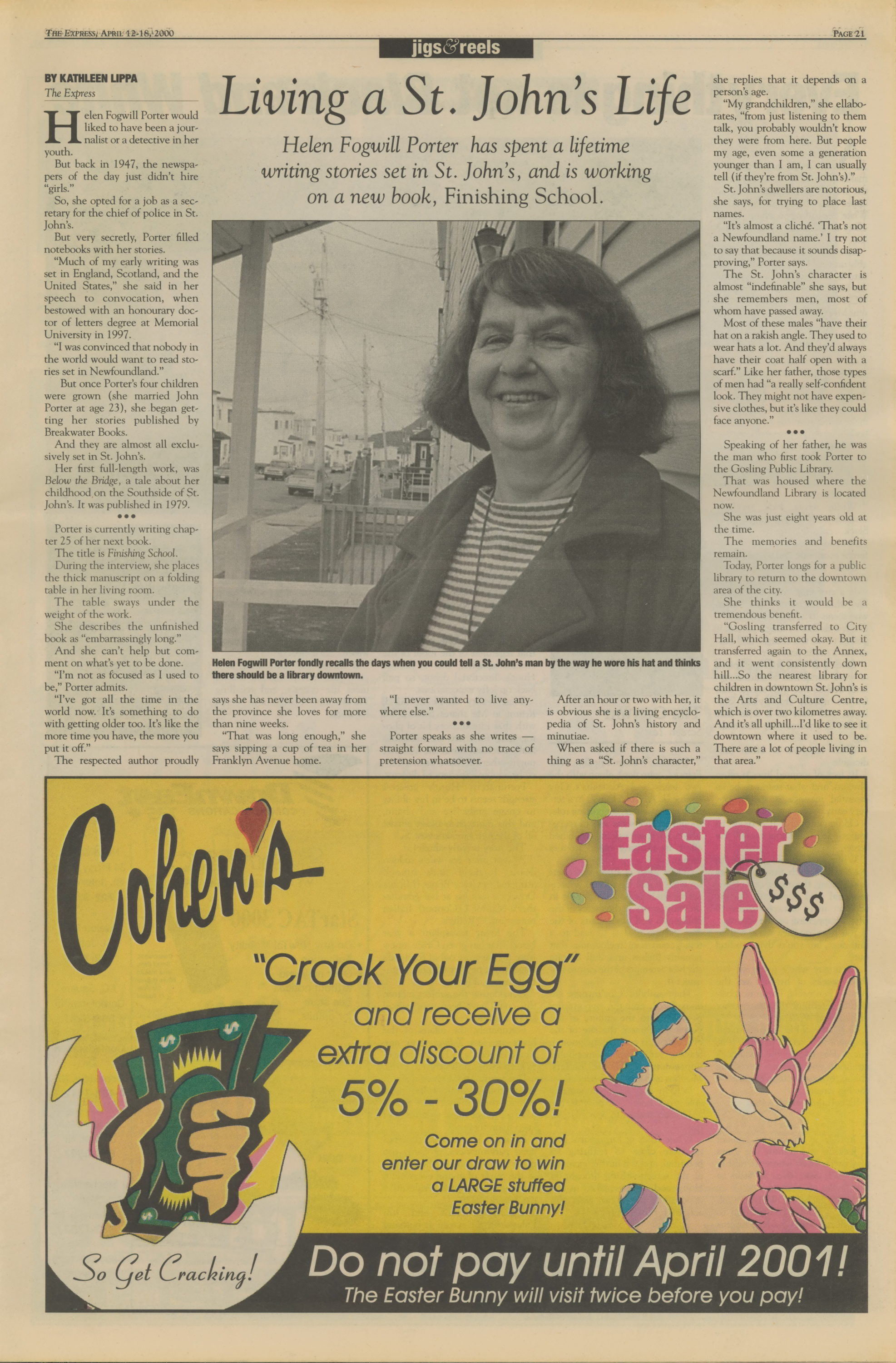Helen Fogwill Porter has spent a lifetime writing stories set in St. John’s, and is working on a new book, Finishing School.

BY KATHLEEN LIPPA
The Express
Helen Fogwill Porter would have liked to have been a journalist or a detective in her youth.
But back in 1947, the newspapers of the day just didn’t hire “girls.” So, she opted for a job as a secretary for the chief of police in St. John’s.
But secretly, Porter filled notebooks with her stories.
“Much of my early writing was set in England, Scotland, and the United States,” she said in her speech to convocation, when bestowed with an honorary doctor of letters degree at Memorial University in 1997.
“I was convinced that nobody in the world would want to read stories set in Newfoundland.”
But once Porter’s four children were grown (she married John Porter at age 23), she began getting her stories published by Breakwater Books. And they are almost all exclusively set in St. John’s. Her first full-length work, Below the Bridge, is a tale about her childhood on the Southside of St. John’s. It was published in 1979.
Porter is currently writing chapter 25 of her next book, Finishing School.
During the interview, she places the thick manuscript on a folding table in her living room.
The small card-table sways under the weight of the work. She describes the unfinished book as “embarrassingly long…I’m not so focused as I used to be,” Porter admits.
“I’ve got all the time in the world now. It’s something to do with time going too late. It’s like the more time you have, the more you put it off.”
The respected author proudly says she has never been away from the province she loves for more than nine weeks. “That was long enough,” she says sipping a cup of tea in her Franklyn Avenue home.
Porter fondly recalls the days you could tell a St. John’s man by the way he wore his hat and thinks there should be a library downtown.
Porter speaks as she writes — straight forward with no trace of pretension whatsoever.
After an hour or two with her, it is obvious she is a living encyclopedia of St. John’s history and media.
When asked if there is such a thing as a “St. John’s character,” she replies that it depends on a person’s age.
“My grandchildren,” she elaborates, “from just listening to them talk, you’d probably wouldn’t know they were from here. But people my age, even some a generation younger than I am, you can usually tell (if they’re from St. John’s).”
St. John’s dwellers are notorious, she says, for trying to place last names.
“It’s almost a cliché. ‘That’s not a Newfoundland name.’ I try not to say that because it sounds disparaging,” Porter says.
The St. John’s character is almost “indefinable” she says, but she remembers men, most of whom have passed away. Most of these males “have their hat on a rakish angle. They used to wear hats a lot. And they’d always have their coat half open with a scarf.” Like her father, those types of men had “a really self-confident look. They might not have expensive clothes, but it’s like they could face anyone.”
Speaking of her father, he was the man who first took Porter to the Gosling Public Library.
That was housed where the Newfoundland Library is located now.
She was just eight years old at the time.
The memories and benefits remain.
Today, Porter longs for a public library to return to the downtown area of the city.
She thinks it would be a tremendous benefit.
“Gosling transferred to City Hall, which seemed okay. But it transferred again to the Annex, and it went consistently down hill…So the more central library for children in downtown St. John’s is the Arts and Culture Centre. And it’s over two kilometres away and uphill. I’d like to see it downtown where it used to be. There are a lot of people living in that area.”